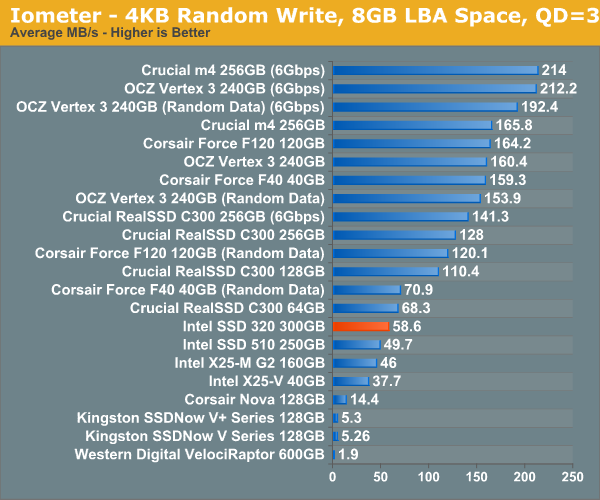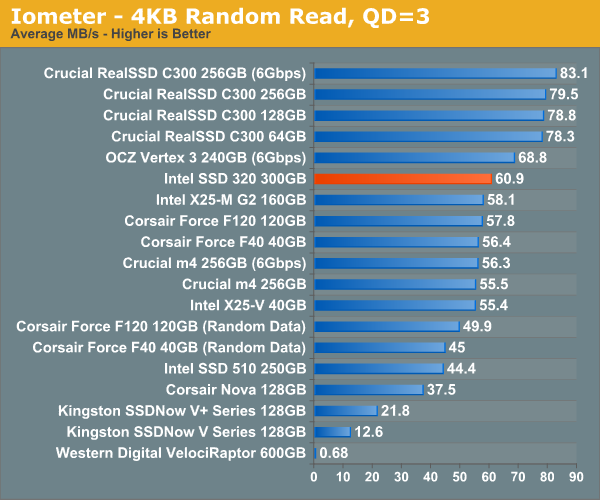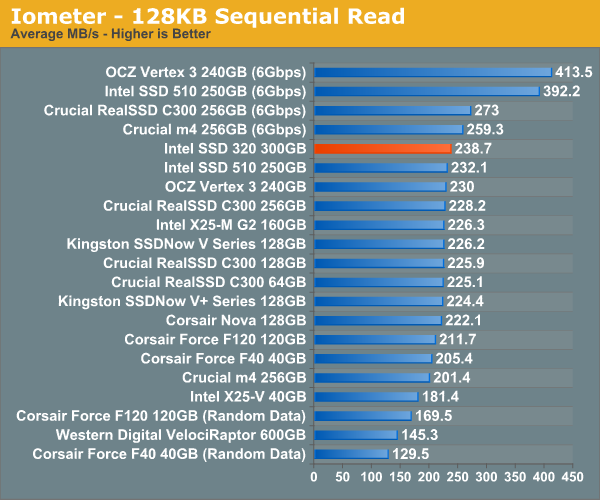The Intel SSD 320 Review: 25nm G3 is Finally Here
by Anand Lal Shimpi on March 28, 2011 11:08 AM EST- Posted in
- IT Computing
- Storage
- SSDs
- Intel
- Intel SSD 320
Random Read/Write Speed
The four corners of SSD performance are as follows: random read, random write, sequential read and sequential write speed. Random accesses are generally small in size, while sequential accesses tend to be larger and thus we have the four Iometer tests we use in all of our reviews.
Our first test writes 4KB in a completely random pattern over an 8GB space of the drive to simulate the sort of random access that you'd see on an OS drive (even this is more stressful than a normal desktop user would see). I perform three concurrent IOs and run the test for 3 minutes. The results reported are in average MB/s over the entire time. We use both standard pseudo randomly generated data for each write as well as fully random data to show you both the maximum and minimum performance offered by SandForce based drives in these tests. The average performance of SF drives will likely be somewhere in between the two values for each drive you see in the graphs. For an understanding of why this matters, read our original SandForce article.

Random write speed is improved compared to the 510 thanks to Intel's controller, but we're only looking at a marginal improvement compared to the original X25-M G2.
Many of you have asked for random write performance at higher queue depths. What I have below is our 4KB random write test performed at a queue depth of 32 instead of 3. While the vast majority of desktop usage models experience queue depths of 0 - 5, higher depths are possible in heavy I/O (and multi-user) workloads:


Random read performance has always been a strong point of Intel's controller and the 320 is no different. While we're not quite up to C300 levels, the 320 is definitely competitive here.
Sequential Read/Write Speed
To measure sequential performance I ran a 1 minute long 128KB sequential test over the entire span of the drive at a queue depth of 1. The results reported are in average MB/s over the entire test length.

Without a 6Gbps interface the 320's performance is severely limited. Compared to other 3Gbps drives the 320 is quite good here though.

Read performance is at the top of the chart for 3Gbps drives. I wonder how far Intel would've been able to push things if the 320 had a 6Gbps controller.










194 Comments
View All Comments
etamin - Monday, March 28, 2011 - link
This is probably a noob question for many of you but can someone explain to me why having a 6gbps controller/interface would increase performance if the drive itself maxes out at 240MB/s sequential read speed (128KB)? isn't 3gbps equal to 384MB/s? If the Intel 320 cannot saturate the SATA 3gbps bandwidth, what good would a 6gpbs bandwidth do for it? similarly, why do a lot of disk drives today have 6gbps interfaces when they can barely saturate 1/3 of a 3gbps interface? Thanks.nonzenze - Monday, March 28, 2011 - link
Because the controller can burst higher if data is handy in a cache.etamin - Tuesday, March 29, 2011 - link
I see. Is there a measure for burst speeds and I'm assuming this only applies to read operations?UNHchabo - Monday, March 28, 2011 - link
SATA uses 8b/10b encoding in all current revisions. This means that the theoretical limit for SATA 3Gb/s is 300MB/s.etamin - Tuesday, March 29, 2011 - link
very interesting, I'll be sure to keep that possibility in mind before converting other standards next time.Chloiber - Tuesday, March 29, 2011 - link
As you can clearly see with SATA3 SSDs running at SATA2, it's way lower.etamin - Thursday, March 31, 2011 - link
yes, that is obvious. I asked because I want to understand the architectural reason behind it.Nentor - Monday, March 28, 2011 - link
They are all so close to each other an unscrupulous HD manufacturer could use them to show there is barely any difference between a SSD and a HD.Why add keep adding them to the SSD articles?
etamin - Monday, March 28, 2011 - link
I think having HDDs in these articles sets a good baseline for those of us who don't already own ssds. Personally I'd actually like to see more hdds like 5400rpm notebook drives since many of these SSDs will be going into notebooks.wvh - Monday, March 28, 2011 - link
What exactly do I need to have encryption support? I've never noticed a SATA password option in my BIOS. Do most laptops support this?Lackluster as the performance seems to be, encryption support and increased reliability – while not sexy – are important, too. If not the enthusiast market, the corporate world might have more interest in such drives.